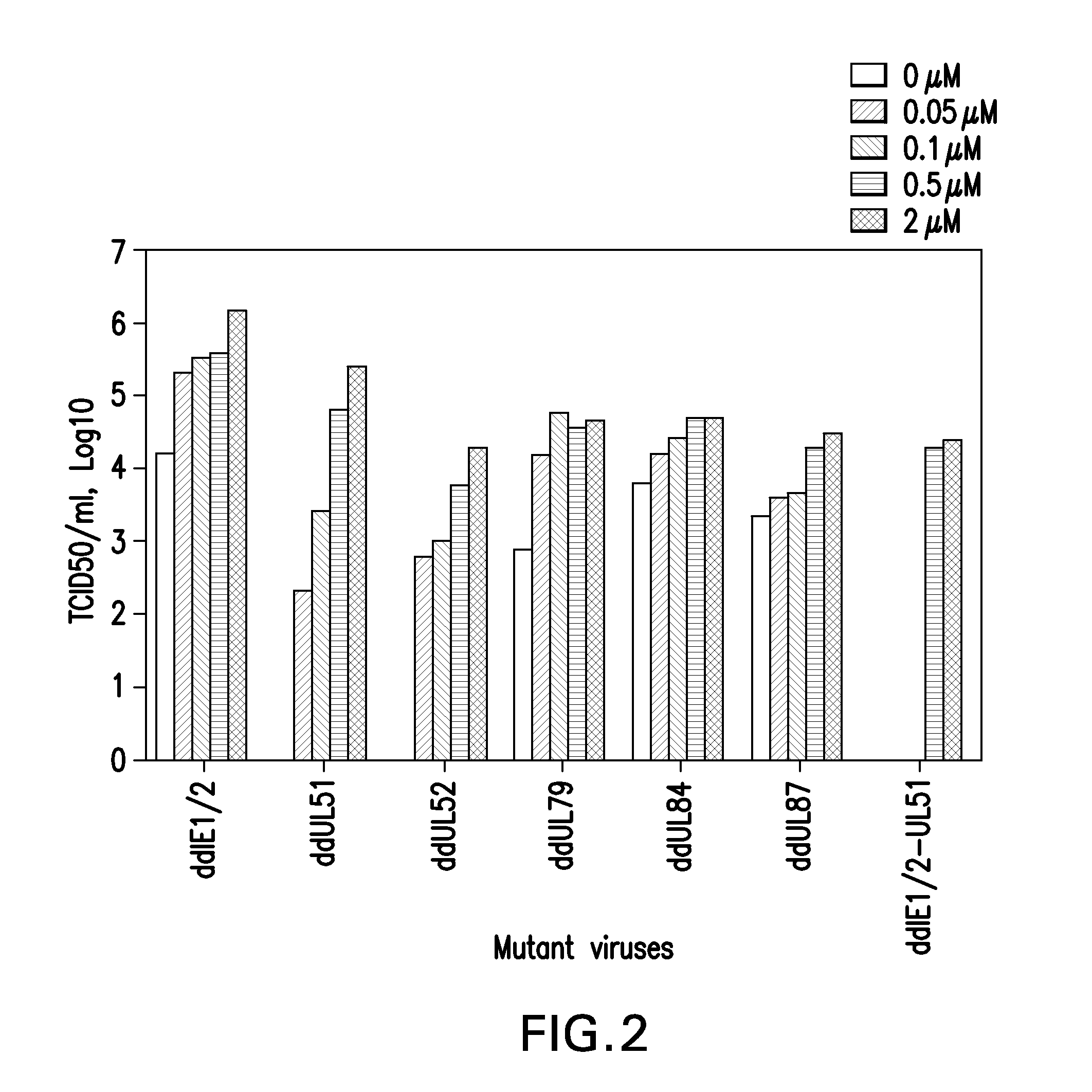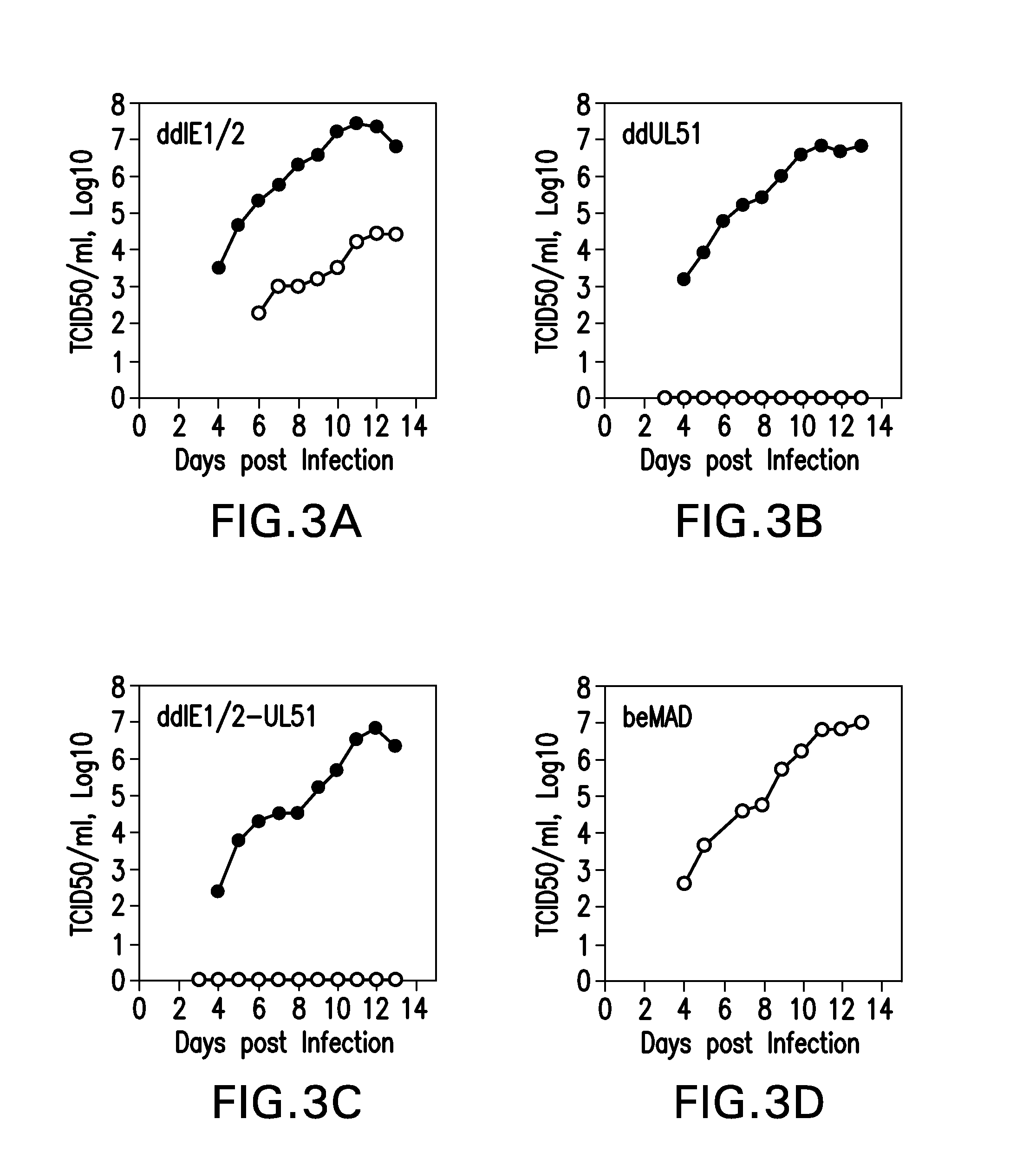Conditional replicating viral vectors
a technology of viral vectors and vectors, applied in the field of cytomegalovirus, can solve the problems of difficult control of transfection efficiency and expression, inability to repeat the use of these systems, and both limitations of gene transfer applications, so as to reduce the severity/length of infection in the patient, and reduce the likelihood or severity of infection
- Summary
- Abstract
- Description
- Claims
- Application Information
AI Technical Summary
Benefits of technology
Problems solved by technology
Method used
Image
Examples
example 1
Restoration of the Pentameric gH Complex
[0180]An infectious CMV bacterial artificial chromosome clone was constructed so that the encoded virion that expressed the pentameric gH complex consisting of UL128, UL130 and UL131 assembled onto a gH / gL scaffold.
[0181]CMV strain AD169 strain was originally isolated from the adenoids of a 7-year-old girl (Elek and Stern, 1974, Lancet, 1:1). The virus was passed 58 times in several types of human fibroblasts to attenuate the virus (Neff et al, 1979, Proc Soc Exp Biol Med, 160:32, with the last 5 passages in WI-38 human fibroblasts. This passaged variant of AD169 virus, referred in this study as Merck AD169 (MAD169), was used as the parental virus to construct the infectious BAC clone. Neither the parental virus AD169 nor the passaged variant virus MAD169 expressed UL131 or the pentameric gH complex.
[0182]The MAD169 was used as the parental virus to construct an infectious bacterial artificial chromosome (BAC) clone. A BAC vector is a molecula...
example 2
Construction and Screening of FKBP-Essential Protein Fusions
[0186]A conditionally replicative defective CMV was constructed using the attenuated AD169 strain as backbone (MAD169).
[0187]Viral proteins to be fused to the FKBP derivative were selected based on two criteria. First, the proteins of interest were not detected in CMV virions by proteomics analysis (Varnum et al., 2004, J. Virol. 78:10960), thus decreasing the likelihood that the FKBP fusion protein will be incorporated into virus. Second, the proteins of interest are essential for viral replication in tissue culture.
[0188]Examples are provided using beMAD as the parental virus. The FKBP derivative (SEQ ID NO:26) was fused to 12 essential viral proteins individually, yielding the fusion proteins FKBP-IE1 / 2 (SEQ ID NO:1), FKBP-UL37x1 (SEQ ID NO:3), FKBP-UL44 (SEQ ID NO:5), FKBP UL51 (SEQ ID NO:7), FKBP-UL52 (SEQ ID NO:9), FKBP-UL53 (SEQ ID NO:11), FKBP-UL56 (SEQ ID NO:13), FKBP-UL77 (SEQ ID NO:15), FKBP-UL79 (SEQ ID NO:17), ...
example 3
Immunogenicity of the IE1 / 2-UL51 Double Fusion Virus in Animals
[0194]The immunogenicity of the IE1 / 2-UL51 double fusion virus was evaluated in mice, rabbits and rhesus monkeys. Dose dependent neutralizing response against the IE1 / 2-UL51 double fusion virus or the parental beMAD virus in mice was first compared (FIG. 5A). Six-week-old female BALB / c mice were immunized at weeks 0 and 4 with beMAD or the IE1 / 2-UL51 double fusion virus at doses ranging from 0.12 μg to 10 μg. Serum samples from week 6 were collected and analyzed by CMV micro-neutralization assay on ARPE-19 cells as described previously (Tang et al, Vaccine, “A novel throughput neutralization assay for supporting clinical evaluations of human cytomegalovirus vaccines” e-published Aug. 30, 2011 at doi:10.1016 / j.vaccine.2011.08.086). The responses were compared at doses of 0.12, 0.37, 1.1, 3.3 and 10 μg. At the low dose range (0.12 to 1.1 μg), the beMAD was slightly more immunogenic with neutralizing antibodies consistently...
PUM
| Property | Measurement | Unit |
|---|---|---|
| Fraction | aaaaa | aaaaa |
| Composition | aaaaa | aaaaa |
| Concentration | aaaaa | aaaaa |
Abstract
Description
Claims
Application Information
 Login to View More
Login to View More - R&D
- Intellectual Property
- Life Sciences
- Materials
- Tech Scout
- Unparalleled Data Quality
- Higher Quality Content
- 60% Fewer Hallucinations
Browse by: Latest US Patents, China's latest patents, Technical Efficacy Thesaurus, Application Domain, Technology Topic, Popular Technical Reports.
© 2025 PatSnap. All rights reserved.Legal|Privacy policy|Modern Slavery Act Transparency Statement|Sitemap|About US| Contact US: help@patsnap.com



